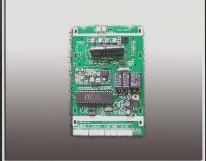1. PCB aluminum substrates are known by various names, including aluminum cladding, aluminum PCB, metal clad printed circuit board (MCPCB), thermally conductive PCB, and others. The key advantage of PCB aluminum substrates is their superior heat dissipation compared to standard FR-4 structures. The dielectric materials used in these substrates typically have thermal conductivities that are 5 to 10 times higher than conventional epoxy glass. Additionally, the heat transfer efficiency of aluminum substrates, even at one-tenth of the thickness, outperforms traditional rigid PCBs. Now, let’s take a closer look at the types of PCB aluminum substrates.
2. **Flexible Aluminum Substrate**
One of the recent advancements in IMS (Insulated Metal Substrate) materials is the development of flexible dielectrics. These materials offer excellent electrical insulation, flexibility, and thermal conductivity. When combined with flexible aluminum materials such as 5754 or similar alloys, they can be molded into various shapes and angles. This flexibility eliminates the need for expensive mounting devices, cables, and connectors. While these materials are flexible, they are designed to bend into shape and remain in place.
3. **Hybrid Aluminum Substrate**

In the “hybrid” IMS structure, the non-thermal “sub-components” are processed independently, and then the Amitron Hybrid IMS PCBs are bonded to the aluminum substrate using thermal materials. The most common configuration is a 2-layer or 4-layer subassembly made of traditional FR-4, which is then bonded to an aluminum substrate with a thermally conductive material to enhance heat dissipation, increase rigidity, and provide shielding. Other advantages include:
1. The cost is lower compared to using only heat-conductive materials.
2. It offers superior thermal performance compared to standard FR-4 products.
3. It can eliminate the need for expensive radiators and related assembly steps.
4. It is suitable for RF applications requiring the RF loss characteristics of the PTFE surface layer.
5. Component windows in the aluminum allow for the accommodation of through-hole components, enabling connectors and cables to pass through the substrate while maintaining a sealed connection without the need for special gaskets or costly adapters.
**Three, Multilayer Aluminum Substrate**
In the high-performance power supply market, multilayer IMS PCBs are constructed from multiple layers of thermally conductive dielectrics. These structures feature one or more layers of circuits embedded within the dielectric, with blind vias used as thermal vias or signal paths. While single-layer designs are typically more expensive and less efficient in heat transfer, they still offer a straightforward and effective cooling solution for more complex designs.
**Four, Through-Hole Aluminum Substrate**
In more complex configurations, a layer of aluminum can serve as the “core” of the multilayer thermal structure. Prior to lamination, the aluminum is electroplated and filled with dielectric material. Thermal materials or sub-components can then be laminated onto both sides of the aluminum using thermal adhesives. Once laminated, the final assembly resembles a traditional multilayer aluminum substrate, with drilled plated through-holes passing through the aluminum to maintain electrical insulation. Alternatively, a copper core can allow for direct electrical connections as well as insulating vias.
If you have any PCB manufacturing needs, please do not hesitate to contact me.Contact me
2. **Flexible Aluminum Substrate**
One of the recent advancements in IMS (Insulated Metal Substrate) materials is the development of flexible dielectrics. These materials offer excellent electrical insulation, flexibility, and thermal conductivity. When combined with flexible aluminum materials such as 5754 or similar alloys, they can be molded into various shapes and angles. This flexibility eliminates the need for expensive mounting devices, cables, and connectors. While these materials are flexible, they are designed to bend into shape and remain in place.
3. **Hybrid Aluminum Substrate**

In the “hybrid” IMS structure, the non-thermal “sub-components” are processed independently, and then the Amitron Hybrid IMS PCBs are bonded to the aluminum substrate using thermal materials. The most common configuration is a 2-layer or 4-layer subassembly made of traditional FR-4, which is then bonded to an aluminum substrate with a thermally conductive material to enhance heat dissipation, increase rigidity, and provide shielding. Other advantages include:
1. The cost is lower compared to using only heat-conductive materials.
2. It offers superior thermal performance compared to standard FR-4 products.
3. It can eliminate the need for expensive radiators and related assembly steps.
4. It is suitable for RF applications requiring the RF loss characteristics of the PTFE surface layer.
5. Component windows in the aluminum allow for the accommodation of through-hole components, enabling connectors and cables to pass through the substrate while maintaining a sealed connection without the need for special gaskets or costly adapters.
**Three, Multilayer Aluminum Substrate**
In the high-performance power supply market, multilayer IMS PCBs are constructed from multiple layers of thermally conductive dielectrics. These structures feature one or more layers of circuits embedded within the dielectric, with blind vias used as thermal vias or signal paths. While single-layer designs are typically more expensive and less efficient in heat transfer, they still offer a straightforward and effective cooling solution for more complex designs.
**Four, Through-Hole Aluminum Substrate**
In more complex configurations, a layer of aluminum can serve as the “core” of the multilayer thermal structure. Prior to lamination, the aluminum is electroplated and filled with dielectric material. Thermal materials or sub-components can then be laminated onto both sides of the aluminum using thermal adhesives. Once laminated, the final assembly resembles a traditional multilayer aluminum substrate, with drilled plated through-holes passing through the aluminum to maintain electrical insulation. Alternatively, a copper core can allow for direct electrical connections as well as insulating vias.
If you have any PCB manufacturing needs, please do not hesitate to contact me.Contact me



